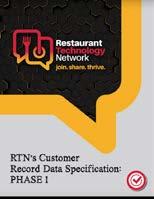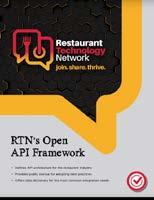RTN’s Transactional Data Specification



Transactional Data Standard, Phase 1 includes: The Restaurant Transactional Data Specification and related technical documentation was created to alleviate compilations related to challenges identified here.
Restaurant transactional data, whether financial, marketing, or operational, makes up the basis for a modern, data-driven company, but many restaurants do not have access or simply cannot ingest this data to make meaningful decisions. This workgroup created processes and technical requirements to simplify transactional categories, to help restaurants aggregate, analyze, and act on valuable data in real time.
VP and Brand Director, HT Co-Founder, RTN 973.607.1358
ANGELA DIFFLY Co-Founder, RTN 404.550.7789
Copyright
Senior Director, Technology & Information American Hotel & Lodging Association sangel@ahla.com
ROBERT FIRPO-CAPPIELLO Editor in Chief, HT 917.208.7393


ANNA WOLFE Senior Editor, HT 207.773.1154
Senior Account Executive, HT & RTN 785.424.7392
NOELL DIMMIG Account Executive, HT & RTN 973.607.1370








Brand Marketing Manager, HT & RTN 908.433.2796
Membership Manager, RTN 314.570.4798
Director of Marketing, Communications and Membership, RTN cczmyr@ensembleiq.com
Technology
Ave., Suite 200, Chicago, IL 60631.












An employee
• The employee exists in the time card system
• The employee is scheduled to clock in
TIME CARDCLOCK IN
TIME CARDBREAK OUT
TIME CARDBREAK IN
in
break
then
TIME CARDCLOCK OUT
• The payroll system is subscribed to receive updates from the time card system
• The payroll system maintains a list of employee information including the employee ID
• The time card system publishes a Clock In time card transaction event generating a unique identifier for the new series of clock events (TimeCardCorrelationGUID) for this employee for this shift utilizing the RTN_EventNotifRQ message with the EventType = TimeCard to be received by the subscribing systems.
• The time card system publishes a Break Out time card transaction event re-using the unique identifier that was generated during the ClockIn event (linking the two events together via the identifier) utilizing the RTN_EventNotifRQ message with the EventType = TimeCard to be received by the subscribing systems.
• The time card system publishes a Break In time card transaction event using the unique identifier that was generated during the Punch In event (linking the three events together via the identifier) utilizing the RTN_EventNotifRQ message with the EventType = TimeCard to be received by the subscribing systems.
• The time card system publishes a Clock Out time card transaction event using the unique identifier that was generated during the Punch In event (linking the four events together via the identifier) utilizing the RTN_EventNotifRQ message with the EventType = TimeCard to be received by the subscribing systems.
Card Event
Time Card Event
Time Card
diagram demonstrates how the time card event messages may be used for the series of events identified above.
• A customer places an order through an employee at a counter.
• The order is sent by the ordering system to the kitchen to be made.
• The employee receives the cash payment from the customer, the drawer opens and the employee places the money in the till and the system closes the order.
• Menu items exist and are available in the ordering system.
• Employee has clocked in and is available to take the order.
• The till has previously been assigned to the employee, and is ready for transactions.
• Kitchen production, labor management, and inventory management, cash management, and surveillance systems are subscribed to receive these messages.
• An order is built and an orderID is created by the ordering system.
• Upon completion of the order, the message is published with a status of “sent” and received by the kitchen production system utilizing the RTN_ EventTransactionRQ with the EventType = Order.
• The customer pays for the order.
• The order is updated with payment information and is changed to a status of “closed” utilizing the RTN_EventTransactionRQ with the EventType = Order.
• The orderID is sent in the ReferencedTransaction field to link the order to the drawer transaction (payment) utilizing the RTN_EventTransactionRQ with the EventType = Drawer.
Order Event Drawer Event
diagram demonstrates how the order and drawer event messages may be used for the series of events as described above.
• A customer places an order through a restaurant website.
• The order is sent by the ordering system to the restaurant’s kitchen to be made.
• The customer pays for the order by credit card through the restaurant’s online ordering system and completes the order.
• Menu items and pricing exist and are available in the ordering system.
• The customer has access to the online ordering system, and the ability to pay for the order using an approved method of payment.
• An order transaction engine is subscribed to receive these messages.
• An order is built and an orderID is created by the ordering system.
• The customer enters credit card information for payment and finalizes the order.
• Upon completion, the order is published with a status of “closed” and received by the order transaction engine utilizing the RTN_EventTransactionRQ message with the EventType = Order.
1.
This diagram demonstrates how the order event message may be used for the event as described above.
Reservations
• A customer secures a restaurant reservation through an online booking system, and later alters the reservation to reflect a change in the number of guests in the party.
• A guest creates a reservation at a restaurant using a third-party online booking site for a party of 2 and later changes the reservation to accommodate a party of 4.
• The restaurant has availability for the time and party size of the customer requests.
• The restaurant is subscribed to receive the reservation messages.
• A reservation with a reservationID is created by the online reservation system.
• Upon completion of the reservation, the reservation is published utilizing the RTN_EventTransactionRQ message with the EventType = Reservation and the subscribing systems receive the message.
• A reservation transaction with the same reservationID as the original reservation is created with the updated reservation information by the online reservation system. Upon completion of the reservation, the reservation is published utilizing the RTN_EventTransactionRQ message with the EventType = Reservation and the subscribing systems receive the message.
• The orderID is sent in the ReferencedTransaction field to link the order to the drawer transaction (payment) utilizing the RTN_EventTransactionRQ with the EventType = Drawer.
Publisher
Reservation Event
Reservation Event
This diagram demonstrates how the reservation event message may be used for the series of events as described above.
• A customer places an order for a pizza and soda through an employee at a counter. The order is created and sent by the ordering system to the kitchen to be made.
• The customer then asks to change the order to purchase an iced tea rather than the soda, so the soda is voided and an iced tea is added to the order.
• Menu items exist and are available in the ordering system.
• Employee has clocked in and is available to take the order.
• The till has previously been assigned to the employee, and is ready for transactions.
• Kitchen production, labor management, and inventory management, cash management, and surveillance systems are subscribed to receive these messages.
• An order is built that includes a pizza and soda and an orderID is created by the ordering system.
• Upon completion of the order, the order message is published with a status of “sent” and received by the kitchen production system, utilizing the RTN_Event TransactionRQ message with the EventType = Order.
• The order is modified to void the soda and add an iced tea.
• Upon completion of the order, the order message is published with the status of “sent” utilizing the same order ID as the original order.
• The order is received by the kitchen production system utilizing the RTN_Event TransactionRQ message with the EventType = Order.
• The customer pays for the order.
• The order is updated with payment information and is changed to a status of “closed” utilizing the RTN_Event TransactionRQ message with the EventType = Order.
• The orderID is sent in the ReferencedTransaction field to link the order to the drawer transaction (payment) utilizing the RTN_EventTransactionRQ message with the EventType = Drawer.
diagram demonstrates how the order and drawer event messages may be used for the series of events as described above.
• An item from the order is refunded after the order is closed.
• A customer places an order for a pizza and soda through an employee at a counter. The order is created and sent by the ordering system to the kitchen to be made.
• The customer is unhappy with the quality of the pizza and the manager refunds the price of the pizza.
• Cash is returned to the customer from the cash drawer.
• Menu items exist and are available in the ordering system
• Employee has clocked in and is available to take the order
• The till has previously been assigned to the employee and is ready for transactions
• Kitchen production, labor management, and inventory management, cash management, and surveillance systems are subscribed to receive these messages.
• The refund is being made during the same business day that the order was created.
• An order is built that includes a pizza and soda and an orderID is created by the ordering system.
• Upon completion of the order, the message is published with a status of “sent” and received by the kitchen production system utilizing the RTN_EventTransactionRQ message with the EventType = Order.
• The customer pays for the order.
• The order is updated with payment information and is changed to a status of “closed” utilizing the RTN_EventTransactionRQ message with the EventType = Order.
• The orderID is sent in the ReferencedTransaction field to link the order to the drawer transaction (payment) utilizing the RTN_EventTransactionRQ message with the EventType = Drawer.
• A refund is created utilizing the refund object.
• The orderID of the original order is included in the OrderID field in the order object. The Payment object on the Order reflects the payment amount and information from the original order.
• The Payment object on the Refund object reflects the amount of the refund as a negative amount.
• The OrderItem object on the order reflects the items being refunded, in this case the pizza and the tax on the pizza reflected as negative amounts.
• Upon completion of the refund, the message is published utilizing the RTN_ EventTransactionRQ message with the EvenType = Refund
• The refund is given to the customer, the orderID is sent in the ReferencedTransaction field to link the order to the drawer transaction (payment) utilizing the RTN_EventTransactionRQ message with the EventType = Drawer.

• A customer requests a refund for a pizza that they ordered on a previous day.
• The customer is unhappy with the quality of the pizza and the manager refunds the price of the pizza.
• The order is no longer accessible by the ordering system, so a refund is given to the customer but no relationship is made to the original order.
• Cash is returned to the customer from the cash drawer.
• Menu items exist and are available in the ordering system.
• Employee has clocked in and is available to take the order.
• The till has previously been assigned to the employee, and is ready for transactions.
• Kitchen production, labor management, and inventory management, cash management, and surveillance systems are subscribed to receive these messages.
• The refund is being made on a later business day than when the order was created.
• A refund is created utilizing the refund object.
• The Payment object on the Refund object reflects the amount of the refund as a negative amount.
• The OrderItem object on the order reflects the items being refunded, in this case the pizza and the tax on the pizza reflected as negative amounts.
• Upon completion of the refund, the message is published utilizing the RTN_ EventTransactionRQ message with the EventType = Refund.
• The refund is given to the customer, the RefundID is sent in the ReferencedTransaction field to link the Refund to the drawer transaction (cash refund) and a negative amount is sent in the CashManagement object indicating the removal of cash from the drawer utilizing the RTN_EventTransactionRQ message with the EventType = Drawer.

• An order is created and a card payment is made at a casual sit-down restaurant (the waitstaff is ringing in each course when they determine they want it produced for the table).
• The waitstaff inputs the order for the two beverages and appetizer into the ordering system, and the order is sent by the ordering system to the restaurant’s kitchen to be made.
• Five minutes after the appetizer arrives at the table, the waitstaff adds to the order the two entrees into the ordering system and the order is sent by the ordering system to the restaurant’s kitchen to be made.
• After clearing the entrees from the table, the waitstaff enters the order for the dessert into the ordering system and the order is sent by the ordering system to the restaurant’s kitchen to be made.
• The customer pays the waitstaff for the order by credit card and the server inputs the payment into the payment system, but keeps the order in an open state allowing for a second transaction to include a tip to be added to the payment.
• Once the tip is added, the waitstaff changes the state of the order to closed.
• Menu items exist and are available in the ordering system.
• Employee has clocked in and is available to take the order.
• The till (either physical or virtual) has previously been assigned to the employee and is ready for transactions.
• Kitchen production, labor management, and inventory management, cash management, and surveillance systems are subscribed to receive these messages.
• Every time the order is committed, the message is cumulative and includes all items from the inception of the order.
• An order is built that includes two glasses of red wine and an order of mozzarella sticks by the ordering system.
• The ordering system creates an OrderID and upon completion of the order, the message is published with a status of “sent” each of the items in the order are published with a status of “committed” and received by the kitchen production system utilizing the RTN_EventTransactionRQ message with the EventType = Order.
• The order is updated to include one steak entree and one sea bass entree by the ordering system.
• The ordering system includes the OrderID that was created with the initial order and upon completion of the order, the message is published with a status of “sent”, each of the items in the order are published with a status of “committed” and received by the kitchen production system utilizing the RTN_EventTransactionRQ message with the EventType = Order.
• The order is updated to include one key lime pie by the ordering system.
• The ordering system includes the OrderID that was created with the initial order and upon completion of the order, the message is published with a status of “sent”, each of the items in the order are published with a status of “committed” and received by the kitchen production system utilizing the RTN_EventTransactionRQ message with the EventType = Order.
• The order is updated to include payment information.
• The orderID of the original order is included in the OrderID field in the order object. The Payment object on the Order reflects the payment amount and information from the order.
• The order includes each menu item and the cost associated with it and the Total object includes the total cost of all of the menu items. The order status remains “sent” because the server is waiting to complete the order until a gratuity is added to the payment.
• Upon completion of the payment, the message is published utilizing the RTN_EventTransactionRQ message with the EventType = Order.
• The order is updated to include gratuity as part of the payment and total objects. The orderID of the original order is included in the OrderID field in the order object. The Payment object on the Order reflects the full payment amount (including gratuity) and information from the original order. The order status is set to “closed” and the message is published utilizing the RTN_EventTransactionRQ message with the EventType = Order.
Publisher
1. 2. 3. 5.
Order Event Order Event Order Event
This diagram demonstrates how the order event message may be used for the series of events as described above.
Order Event4.
In an industry built on service and entrepreneurial spirit, purposebuilt technology fuels success. The Restaurant Technology Network aspires to help restaurant professionals and solution providers work together to solve problems large and small and inspire bold ideas for the future.


Click below to explore.
If you have a vested interest in the restaurant technology industry, join us. Collectively, our members shape the industry by creating and disseminating technology standards and technical guidance to benefit members. Through our cornerstone virtual think-tank workgroup meetings, our members solve industry challenges and prosper inside a unique, collaborative environment.
OUT NEW SITE
